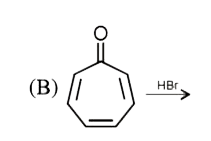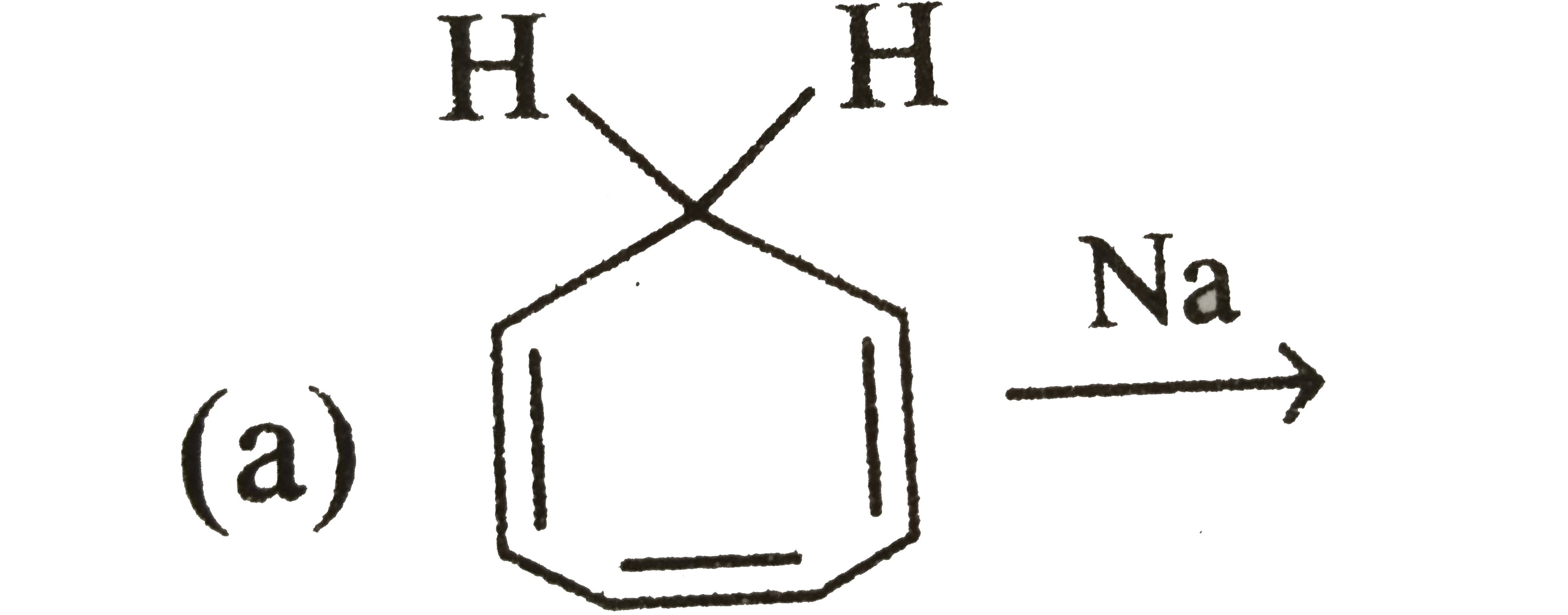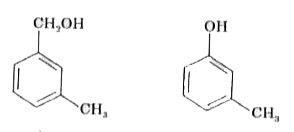Which of the following reactions give aromatic compound ?




The correct Answer is:ABC
To determine which of the given reactions produces an aromatic compound, we need to apply Huckel's rule and check the conditions for aromaticity. Aromatic compounds must meet the following criteria:
1. The compound must be cyclic.
2. The compound must be planar (all atoms in the same plane).
3. The compound must have a continuous ring of p-orbitals (conjugation).
4. The compound must follow Huckel's rule, which states that it must have 4n+2 π electrons, where n is a non-negative integer.
Let's analyze each option step by step:
Step 1: Analyze Option A
- Structure: A five-membered ring with two double bonds.
- Reaction: In the presence of K and heat, H⁻ will be generated, which can remove H⁺ from the ring.
- Resulting Structure: This leads to a negatively charged carbon in the ring.
- Hybridization: All double-bonded carbons are sp² hybridized, and the negative charge is also sp².
- Cyclic and Planar: The structure is cyclic and planar.
- Count π Electrons:
- 2 double bonds contribute 4 π electrons (2 from each double bond).
- The negative charge contributes 1 additional π electron.
- Total = 5 π electrons.
- Conclusion: This does not satisfy Huckel's rule (needs 6 π electrons). Thus, not aromatic.
Step 2: Analyze Option B
- Structure: A six-membered ring with alternating double bonds.
- Reaction: HBr adds to the ring, forming a carbocation.
- Resulting Structure: The carbocation retains the cyclic structure.
- Hybridization: All carbons are sp² hybridized.
- Cyclic and Planar: The structure is cyclic and planar.
- Count π Electrons:
- 3 double bonds contribute 6 π electrons.
- Conclusion: This satisfies Huckel's rule (6 π electrons). Thus, aromatic.
Step 3: Analyze Option C
- Structure: A seven-membered ring with alternating double bonds.
- Reaction: HI adds to the ring, forming a carbocation.
- Resulting Structure: The carbocation retains the cyclic structure.
- Hybridization: The carbocation will have sp³ hybridization.
- Cyclic and Planar: The structure is cyclic but not planar due to sp³ hybridization.
- Count π Electrons:
- The structure has 4 π electrons (due to 2 double bonds).
- Conclusion: This does not satisfy Huckel's rule (needs 6 π electrons). Thus, not aromatic.
Step 4: Analyze Option D
- Structure: A five-membered ring with a carbonyl group and HBr.
- Reaction: HBr adds, forming a carbocation.
- Resulting Structure: The carbocation retains the cyclic structure.
- Hybridization: The carbocation will have sp³ hybridization.
- Cyclic and Planar: The structure is cyclic but not planar due to sp³ hybridization.
- Count π Electrons:
- The structure has 4 π electrons.
- Conclusion: This does not satisfy Huckel's rule (needs 6 π electrons). Thus, not aromatic.
Final Conclusion
From the analysis:
- Option B is the only one that produces an aromatic compound.
2. The compound must be planar (all atoms in the same plane).
3. The compound must have a continuous ring of p-orbitals (conjugation).
4. The compound must follow Huckel's rule, which states that it must have 4n+2 π electrons, where n is a non-negative integer.
- Structure: A five-membered ring with two double bonds.
- Reaction: In the presence of K and heat, H⁻ will be generated, which can remove H⁺ from the ring.
- Resulting Structure: This leads to a negatively charged carbon in the ring.
- Hybridization: All double-bonded carbons are sp² hybridized, and the negative charge is also sp².
- Cyclic and Planar: The structure is cyclic and planar.
- Count π Electrons:
- 2 double bonds contribute 4 π electrons (2 from each double bond).
- The negative charge contributes 1 additional π electron.
- Total = 5 π electrons.
- Conclusion: This does not satisfy Huckel's rule (needs 6 π electrons). Thus, not aromatic.
- Structure: A six-membered ring with alternating double bonds.
- Reaction: HBr adds to the ring, forming a carbocation.
- Resulting Structure: The carbocation retains the cyclic structure.
- Hybridization: All carbons are sp² hybridized.
- Cyclic and Planar: The structure is cyclic and planar.
- Count π Electrons:
- 3 double bonds contribute 6 π electrons.
- Conclusion: This satisfies Huckel's rule (6 π electrons). Thus, aromatic.
- Structure: A seven-membered ring with alternating double bonds.
- Reaction: HI adds to the ring, forming a carbocation.
- Resulting Structure: The carbocation retains the cyclic structure.
- Hybridization: The carbocation will have sp³ hybridization.
- Cyclic and Planar: The structure is cyclic but not planar due to sp³ hybridization.
- Count π Electrons:
- The structure has 4 π electrons (due to 2 double bonds).
- Conclusion: This does not satisfy Huckel's rule (needs 6 π electrons). Thus, not aromatic.
- Structure: A five-membered ring with a carbonyl group and HBr.
- Reaction: HBr adds, forming a carbocation.
- Resulting Structure: The carbocation retains the cyclic structure.
- Hybridization: The carbocation will have sp³ hybridization.
- Cyclic and Planar: The structure is cyclic but not planar due to sp³ hybridization.
- Count π Electrons:
- The structure has 4 π electrons.
- Conclusion: This does not satisfy Huckel's rule (needs 6 π electrons). Thus, not aromatic.
From the analysis:
- Option B is the only one that produces an aromatic compound.
Topper's Solved these Questions
- GOCBook:MOTIONChapter:GOCExercise:Exercise - 3
Explore 44 Videos
- GOCBook:MOTIONChapter:GOCExercise:Exercise - 4 Level - I
Explore 13 Videos
- GOCBook:MOTIONChapter:GOCExercise:Exercise - 2 (Level - I)
Explore 31 Videos
- GASEOUS STATE Book:MOTIONChapter:GASEOUS STATE Exercise:EXERCISE-4( LEVEL-II)
Explore 19 Videos
- GRIGNARD REAGENTBook:MOTIONChapter:GRIGNARD REAGENTExercise:EXERCISE-2
Explore 16 Videos
Similar Questions
Knowledge Check
Which of the following reactions give aromatic ion ?
A B
B C
C D
D
Which of the following compounds are aromatic ?
A B
B C
C D
D
Which of the following compound(s) is/are aromatic compounds ?
 AI, II and IIIBIII and IVCIV onlyDI, III and IV
AI, II and IIIBIII and IVCIV onlyDI, III and IV
Which of the following is not an aromatic compound ?
View SolutionWhich of the following is not an aromatic compound ?
View SolutionWhich of the following compounds is aromatic alcohol?


View SolutionWhich one of the following is an aromatic compound ?
View SolutionWhich one of the following is an aromatic compound ?
View Solution

